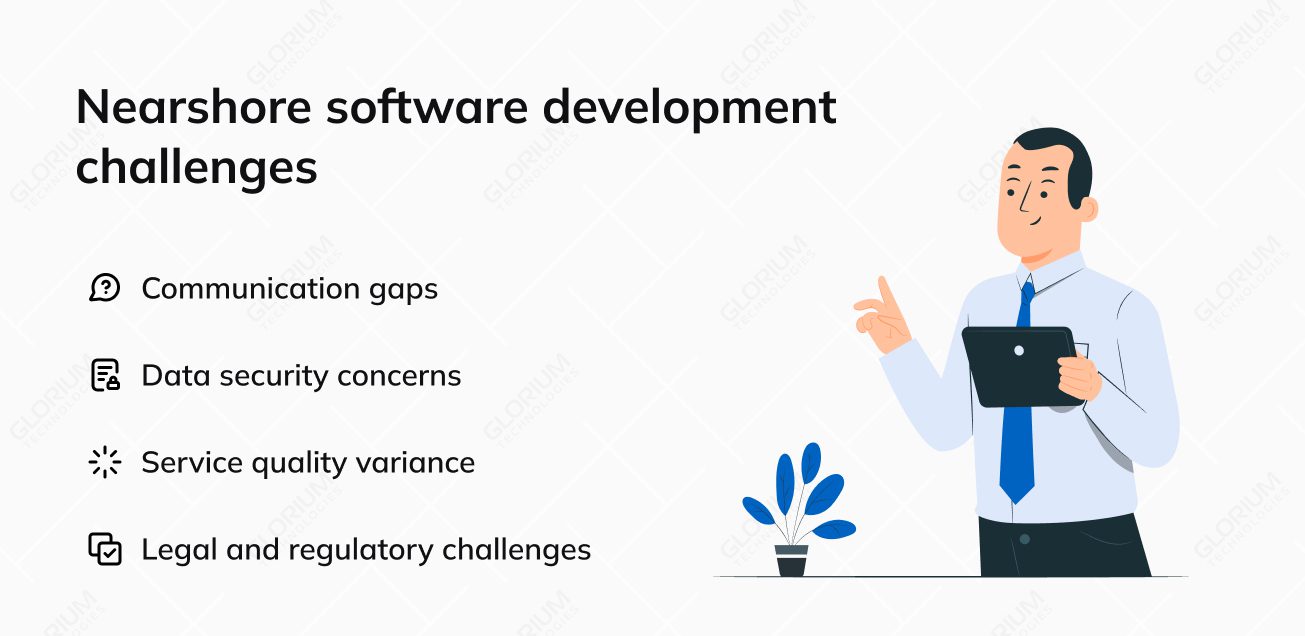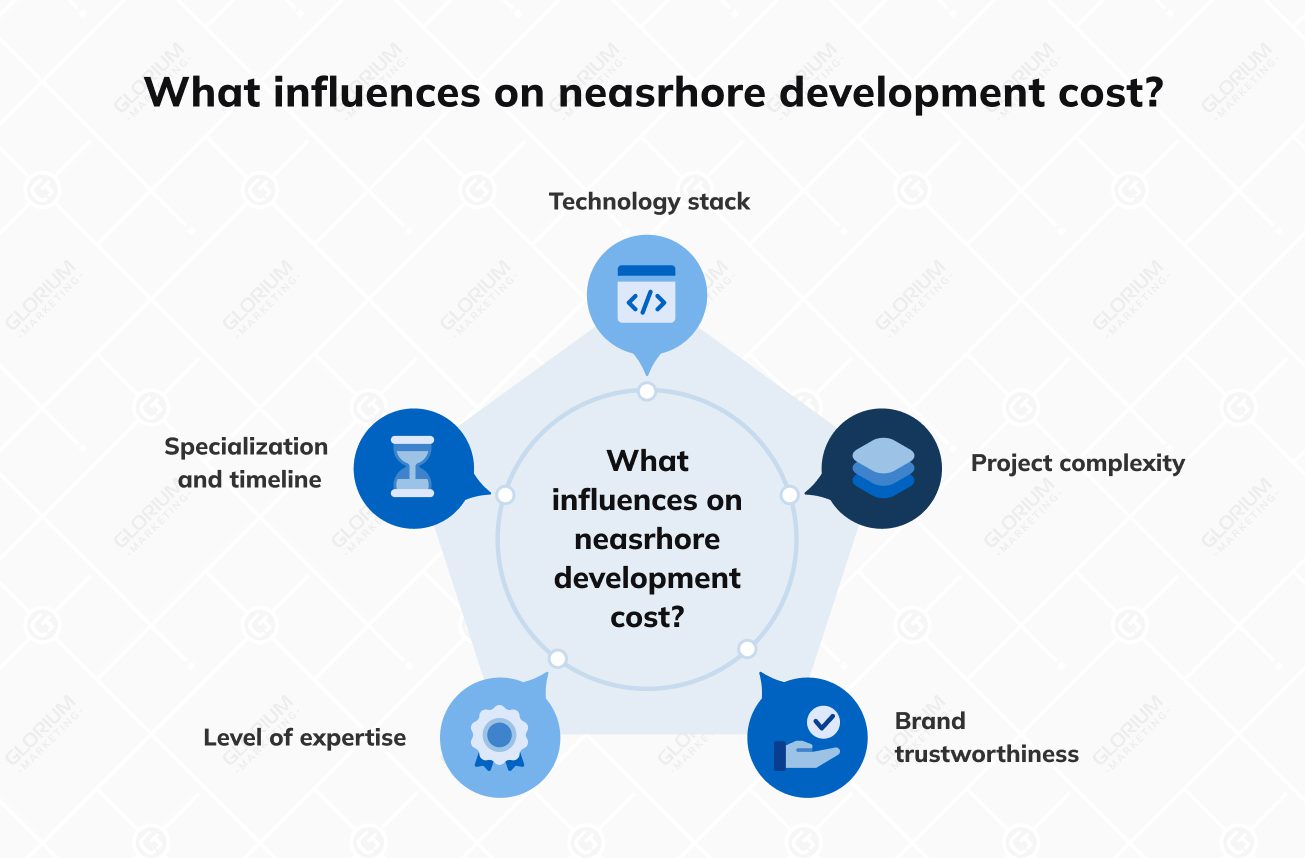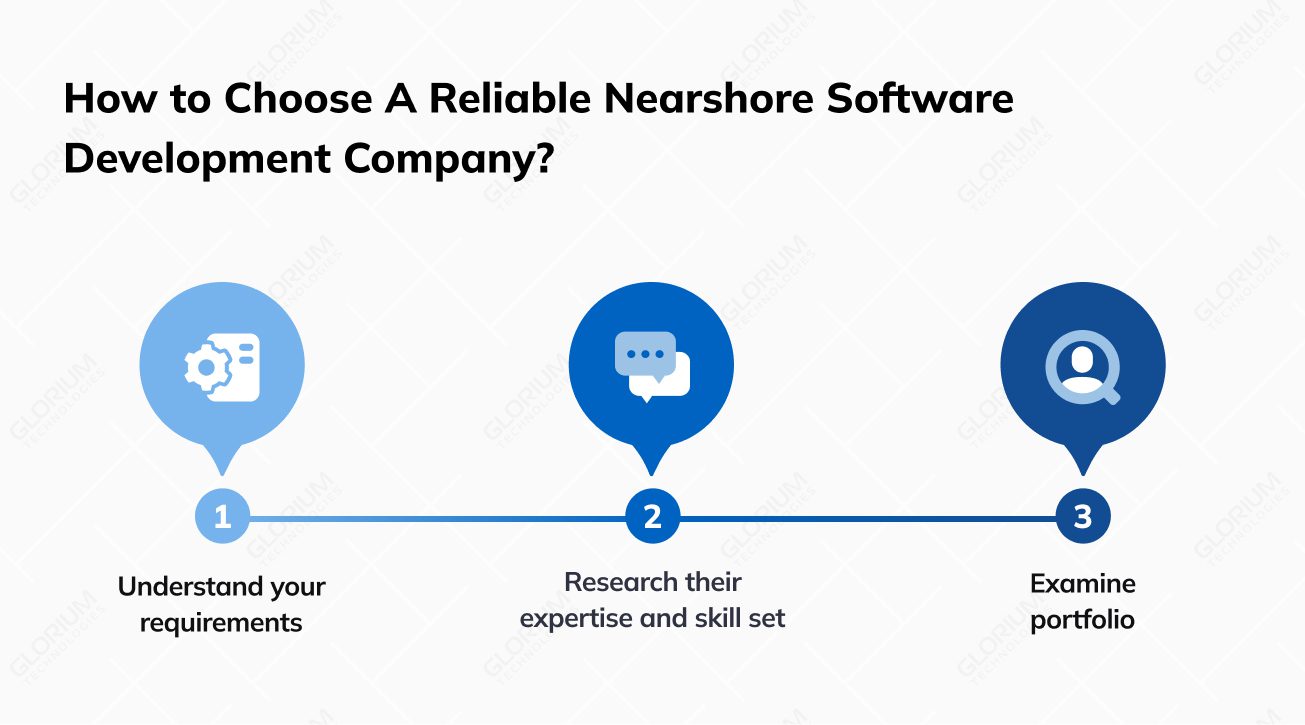
Exploring Nearshore Software Development: Guide to Cost-effective Solution Building



Nearshore software outsourcing describes an effective method of leveraging the intellectual force of neighboring states within one time zone. Such world-renowned corporations as IBM, Johnson & Johnson, EY, Google, Porsche, and Tesla have long relied on nearshore software development to enhance their efficiency and profitability.
These large corporations tend to employ experts from neighboring countries as a promising way to develop their business. The cause is that numerous experts from Eastern Europe, the CIS, and other countries are willing to provide their assistance for a lower fee. However, they have rather high skill sets.
Content
Nearshore software development model, at its core, refers to the practice of outsourcing software development tasks to teams or companies located in neighboring or nearby countries. This approach sits between onshore (hiring teams within one’s own country) and offshore (engaging teams from distant countries) development models. The primary motivation behind adopting nearshoring is to tap into the benefits of geographical proximity, cultural, and time zone proximity while securing competitive pricing and high-quality services.
Startups require agility, adaptability, and swift turnarounds. Nearshore software becomes a fitting choice as it promotes efficient collaboration, shorter communication lag, and the advantage of closely aligned business hours. This geographical closeness often translates to smoother workflows and enhanced team synchronicity.
For example a fintech company in Berlin, Germany, plans to extend its software suite but wants to maintain closer communication and cultural alignment with their external team. This company can choose nearby countries ( in our case it will be European countries) with a nearshore development center.

Still this company has a second option – offshore model. Offshore software development model refers to the process of outsourcing software development tasks or projects to a company or a dedicated development team located in a different country, typically one that is geographically distant from the client’s home country. This model is often adopted to capitalize on cost savings, technical expertise, and round-the-clock productivity. But, there are some challenges: language barriers and time zones difficulties.
So what are the benefits of a nearshore software development team?

So nearshore software development offers many benefits; however, like any approach, it comes with its challenges. Recognizing these challenges can aid businesses in devising strategies to mitigate them. Here are some common obstacles faced in nearshore software outsourcing:

Businesses can significantly mitigate potential risks and obstacles by choosing a reliable and experienced nearshore partner. Such a partner will bring technical expertise and a deep understanding of effective collaboration, communication, and problem-solving across borders. So, while challenges exist, proper collaboration ensures that everything unfolds seamlessly, leading your business toward its desired objectives.
Outsourcing vs offshoring can be an efficient strategy for businesses looking to improve efficiency and benefit from specialized expertise. However, it’s important to carefully consider where and when to implement it to ensure success. By understanding the nuances of each outsourcing model and leveraging the unique advantages of each, companies can effectively tap into global talent while staying true to their core objectives. Let’s delve into situations when your business needs nearshore software development services or offshore outsourcing model.
So the nearshore software is ideal for startups that require close collaboration with software engineers (when distance and cultural differences matter), companies in heavily regulated industries, businesses emphasizing team integration and cohesion, and projects with dynamic, rapidly changing scopes.
But if your business is looking for significant cost savings or you have a startup with well-defined, long-term projects it’s better to consider an offshore development model. Additionally this approach is suitable for companies seeking specific skill sets or substantial resource numbers.
Nearshoring software development often suggests reduced development costs. However, a closer examination reveals some details, which should be taken into consideration when choosing nearshore software companies. Here’s the reason behind these disparities:

Generally, the cost of software development for an nearshore outsourcing model depends on the country which you will choose. We have prepared a visual presentation of the average hourly costs.

When choosing nearshore software developers, it’s important to research and ensure that the company you choose is reliable and trustworthy. Here are a few tips to help you make the right decision:
Before embarking on your search, take a moment to assess and define your specific needs. Are you looking for full-stack development services or just a specialized solution? Are you aiming for a short-term project or a long-term collaboration? Knowing your goals will help you filter and shortlist companies that align with your mission.
Without a clear understanding of what needs to be achieved, it’s like venturing into unknown territory without a map. Here’s an in-depth look for a successful project:
- Target audience: Identify who faces this problem. Is it a niche group or a broader demographic?
- Competitive analysis: Identify existing solutions in the market. Understand their strengths and weaknesses.
- Market size and growth: Assess the potential size of your target market and its growth rate. This will help in understanding the potential scale of your startup.
- Market trends: Stay updated with the latest trends. It’s essential to know if your idea aligns with where the industry is headed.
- Surveys and interviews: Interact directly with potential users. Understand their pain points, preferences, and expectations.
Roman MatsukatovProduct Manager, Glorium Technologies
Only some nearshore development companies will possess the expertise relevant to your project. Dive deep into their offered services, technologies they’re proficient in, and the industries they cater to. For instance, if you’re in the fintech sector, you might want a firm that understands financial software’s intricacies and compliance requirements.
A company’s past work speaks volumes about its capabilities. Delve into their portfolio to understand the diversity of projects they’ve handled, the complexity of solutions they’ve delivered, and the industries they’ve served, who are the software engineers. Case studies can offer insights into their problem-solving abilities, creativity, and technical prowess.
Genuine feedback from past clients can provide a candid view of the company’s strengths and areas of improvement. Platforms like Clutch or Glassdoor can offer unbiased reviews. Look for patterns in feedback; if a specific positive or negative aspect is repeatedly mentioned, it’s likely a consistent company trait.
Since nearshoring involves collaboration across borders, effective communication is crucial. During preliminary discussions, gauge their responsiveness, clarity, and the tools they use for communication. The last thing you want is misunderstandings and misinterpretations delaying or derailing your project.
While nearshore companies will likely share more cultural similarities with you than offshore ones, differences can still exist. Understand their work ethics, corporate values, and business practices. A company whose values align with yours will lead to smoother collaborations and a more cohesive working relationship.
Understanding how the company approaches software development can clarify project timelines, quality assurance, and delivery. Do they follow agile methodologies? How often will you receive updates? What’s their approach to quality assurance and testing? A transparent and structured development process often translates to reliable delivery.
With increasing concerns about data breaches, ensuring that your nearshore partner prioritizes security is non-negotiable. Ask about their data protection policies, encryption practices, and non-disclosure agreements. Safeguarding your intellectual property and sensitive data should be a shared priority.
Business needs can evolve, and having a partner that can adapt is invaluable. Whether you need to scale up the team for a phase or require a specific skill set for a new feature, the company should be equipped to adjust resources accordingly.
While cost savings might be a driving factor for choosing nearshore software development companies, there are better options than the cheapest. Instead of just looking at the price tag, weigh the value the company brings to the table. Expertise, reliability, and a track record of successful projects might justify a slightly higher price point.
Outsourcing mobile app development or any software development doesn’t end with deployment. Ongoing support, maintenance, and updates are crucial for the software’s longevity and relevance. Ensure your chosen company offers robust post-launch Support to navigate any challenges or updates in the future.
Working with Glorium Technologies as a nearshore partner guarantees efficient communication, cultural alignment, and swift project execution.
If you are looking for a reliable nearshore software development company, let’s get in touch.
Nearshore development, lying between onshore and offshore models, capitalizes on the advantages of geographical, cultural, and time zone proximity, ensuring cost-effectiveness and quality. Benefits of nearshore development include cultural affinities, time zone overlap, balanced cost structures, the feasibility of in-person meetings, scalability, access to a thriving tech talent pool, and easier legal navigation.
However, potential challenges, such as communication gaps, data security issues, varying service quality, legal complexities, and overdependence, can be alleviated by partnering with a reliable nearshore company.
To choose a reliable nearshore software development company, businesses must clarify their needs, research company expertise, analyze portfolios, seek genuine testimonials, assess communication and cultural compatibility, understand development processes, prioritize data security, gauge flexibility, weigh value against price, and ensure post-development support.
When deciding between nearshore and offshore development, businesses should consider factors like cultural alignment, cost priorities, the necessity of in-person meetings, regulatory frameworks, and the required talent pool. Nearshore solutions are apt for startups needing close collaboration, those in regulated sectors, and projects with shifting scopes. In contrast, offshore suits businesses prioritizing cost or seeking vast resource numbers.
Costs for nearshore software development can fluctuate based on technology stack, project complexity, specialization, expertise level, and the company’s brand trustworthiness.
Nearshore software development is the outsourcing model which refers to geographically close countries or similar time zones. This approach combines the benefits of both onshore and offshore development, providing cost savings and easier collaboration due to proximity.
Offshore development involves outsourcing to countries that might be on another continent, often resulting in significant time zone differences. On the other hand, Nearshore development is typically closer in proximity, leading to minimal time zone differences, which can facilitate smoother communication and collaboration.
Nearshore development offers cost-effectiveness without compromising on quality. The proximity can lead to better cultural and linguistic alignment, smoother communication, reduced travel expenses, and synchronized working hours.
As with any outsourcing model, there are risks, such as potential communication issues, cultural differences, or variable quality standards. However, choosing a reputable nearshore partner with established credentials can mitigate most risks.
Consider their experience, client testimonials, technological expertise, communication skills, and alignment with your business values. Visiting the partner’s facility or engaging in a pilot project is also wise.
Not necessarily. Quality depends more on the chosen development partner than the geographical location. Many nearshore development firms maintain high-quality standards and are certified in various industry benchmarks.
Nearshore development can often accelerate project timelines due to synchronized working hours, enabling real-time communication, quick feedback loops, and efficient problem-solving.
Yes, nearshore development company can offer significant cost savings compared to onshore development partner ( due to lower labor costs, tax benefits, and reduced overheads while retaining proximity advantages.
Use collaboration tools, schedule regular status updates, and ensure clear documentation. Occasionally visiting the nearshore facility or arranging face-to-face meetings can enhance the relationship and communication.
Absolutely. Many nearshore software development firms have the expertise, resources, and experience to handle complex, large-scale projects. It’s essential to evaluate the capabilities of the potential partner before engagement.








